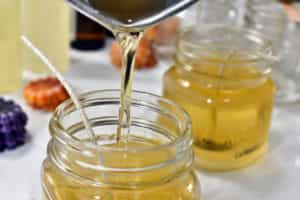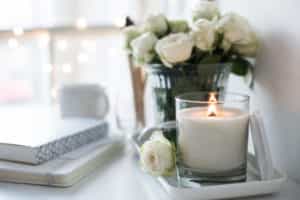What to believe and not to believe …
As autumn approaches, what’s better than confining oneself to one’s sofa, with a good book and a scented candle? It is true that days that are refreshing are conducive to candles, warm and comforting. They are ideal for recreating an atmosphere that we like at home. There is something for every taste ; if you are a fan of the winter season, it will be hot and spicy scents. If, on the other hand, you are nostalgic for the summer, then you can bring the season back to life by getting a scented candle with monoï, with the flower of Ylang-Ylang or with coconut.
However, many of us are wary of candles because lately they have been quite controversial in the press, the media, etc …
Through this article, I will aim to make you discover (or rediscover) what candles actually are, as well as a clear explanation of the “dangers” they present.
What is a candle?
A candle consists of 3 elements: wax, a wick and a fragrance.
The waxes:
- Animal wax: beeswax. It is quite rare and its cost is relatively high.
- Vegetable wax: the most used is soy wax. There is also rapeseed wax in some candles or palm wax, even though it is, like palm oil, currently at the heart of a great ecological debate.
- Mineral wax: paraffin. It comes from petrochemicals and is the most used because its cost is quite low and it is relatively easy to work.
The wick:
It is the engine of the candle. The flame reaches the wax because of the wick.
The wick is most often cotton, but there are also wood wicks that allow good olfactory diffusion.

The fragrance:
The scent of the candle is a complex mixture of olfactory components of natural origin or synthetically made with the purpose of obtaining a particular smell.
Sometimes they are simple notes that reproduce nature like flowers, woods, spices … or familiar tastes such as chocolate, vanilla, caramel, … but often much more complex fragrances: amber, oriental, ….
In all cases it is a real creative work for the perfumer to have an original but also technical perfume in the choice of raw materials to optimise the burning qualities (a beautiful flame that does not smoke) and the diffusion in space.
Why this controversy around candles?
As you have most certainly noticed, more and more reports, documentaries and articles about the dangers of candles are emerging. If we stick to the journalists’ version, we should totally stop the consumption of candles to run no danger. Let’s take a look at it.
We noted here some points about candles criticised by the media:
The burning of wicks
We often hear that burning a wick contributes to indoor pollution, that the candle releases CO2 into the air. But, is this amount of CO2 really comparable to that emitted by a wood fire?
It is true that any combustion releases CO2, and the candle does not escape it. However, is such a small quantity sufficient to deprive oneself of the pleasure of a candle?
The composition of candles
Some have also blamed the presence of cutaneous allergens such as limonene in candles. To put it in context, limonene is a volatile compound that is characteristic of orange. Its essential oil contains more than 90%. In perfumery, it is known as a cutaneous allergen. It is at this level that there is a lot of confusion: a skin allergen is not necessarily a respiratory allergen, and when you burn a candle, the fragrance is not in contact with your skin.
In any case, the perfumer industry follows a very strict regulation to avoid some problems that one could have in time, as it was the case with the benzene. It sometimes happened that traces of toxic solvent were found in some candles of poor quality.

How to best consume a candle?
As you will have understood, before starting to think that each candle presents a danger, one must pay attention to its quality. It is better to go for candles of better quality, even if they are usually more expensive, and follow the ritual of burning:
1) During the first use, let the candle burn until all the wax has melted on the surface.
2) Cut the wick regularly.
A correct burning ritual increases the burning time, it allows to use the candle entirely, it avoids that the candle is hollow in its middle. Quite simply, it increases the duration.
And then, do not forget the main role of a scented candle, all the beautiful sensations it provides. Let’s not forget the power of smell on our brain, the memories they bring and the “feel good” sensation they make us feel.